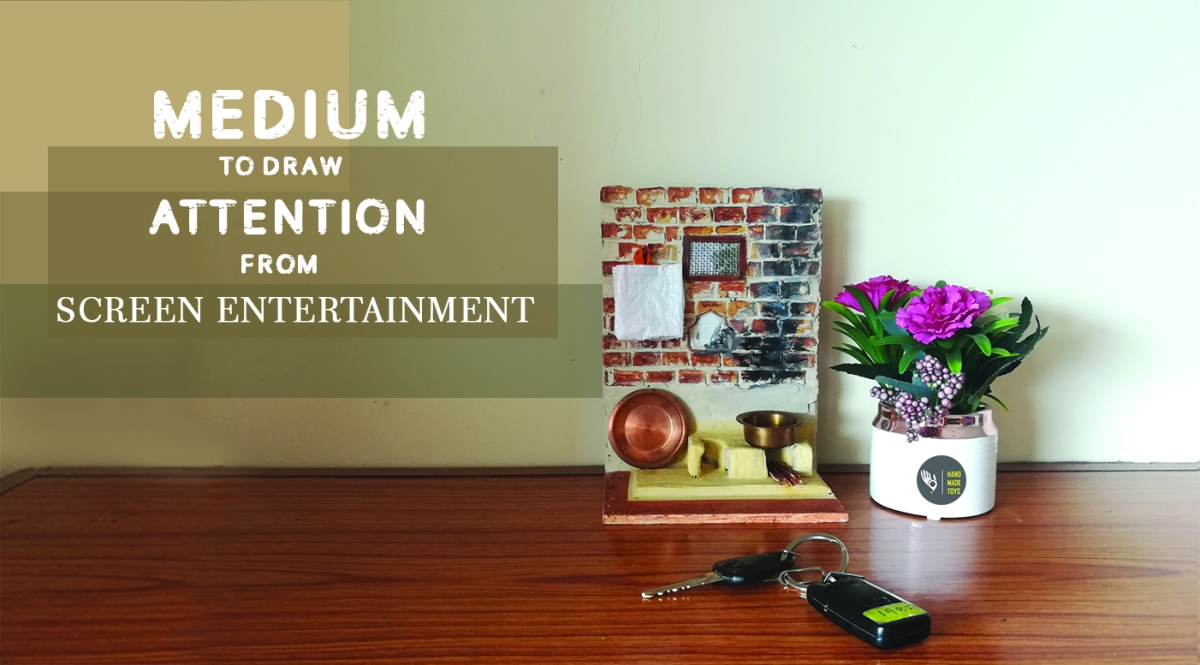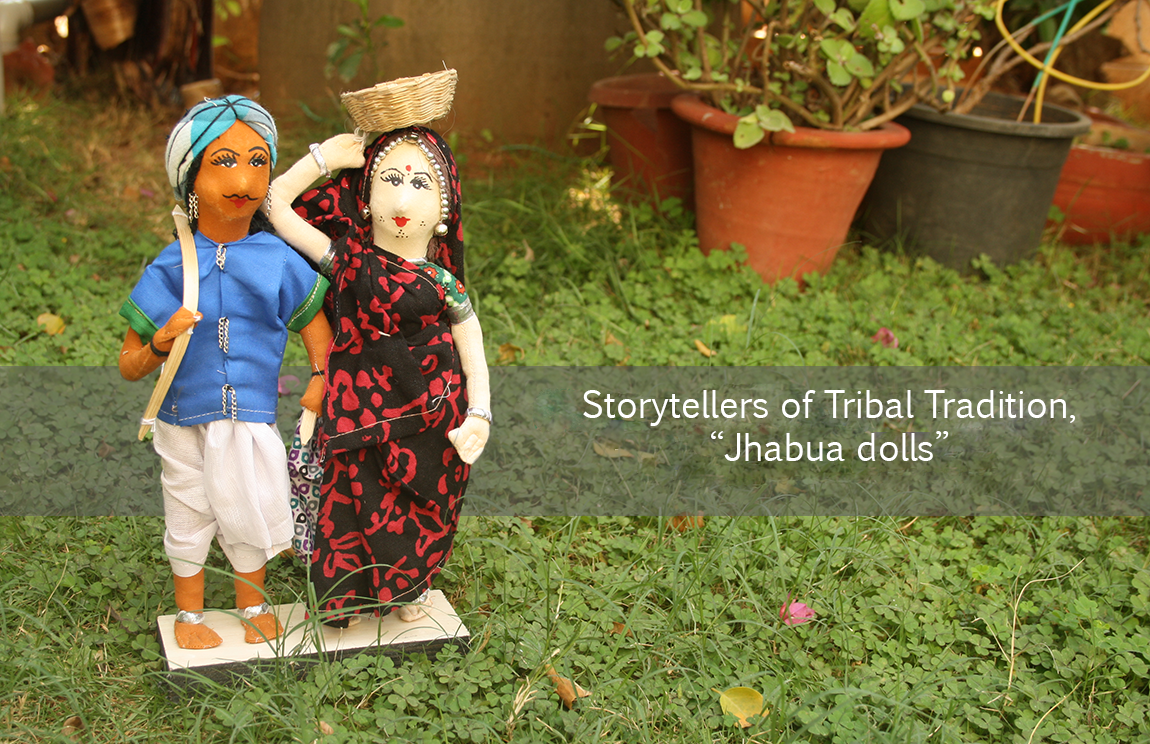Tag: legacy of culture
Alternative Medium for children to draw attention away from Screen Entertainment.
As a student of textile design at a craft-oriented college in Rajasthan, I was given the opportunity to delve deep into the rich cultural heritage of India. My specialization in textile design allowed me to gain a unique understanding of how cultural influences, such as history, geography, and climate, shape the indigenous clothing and craft traditions of different regions. This sparked my curiosity to not only appreciate the craftsmanship, but also to gain a deeper understanding of the lifestyle and culture of the craftspeople.

I love to travel, although it’s not that easy to do it on top of a professional 9-to-5 job, but somehow I manage to do it when I want it badly enough.
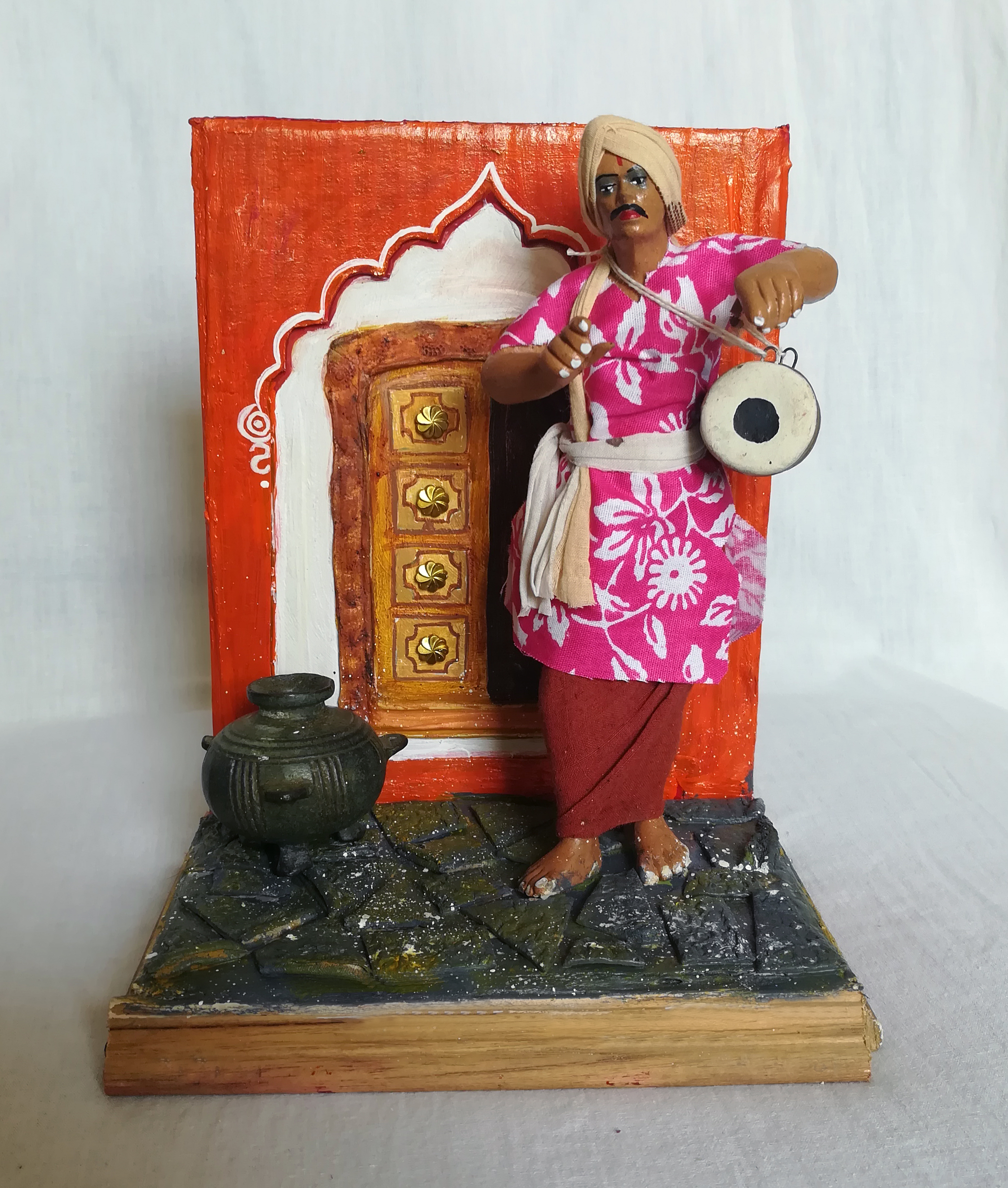
The culture of India is one of the most ancient and unique. The South, the North and the Northeast have their own distinct cultures and almost every state has created its own cultural niche. There is hardly any culture in the world as diverse and unique as India’s. But due to urbanization of young generation on one hand, where we are becoming a multicultural society, on the other hand, we are losing our distinct tradition and its cultural values.We can clearly understand as if, so many rituals and customs followed our grandparents; in the next generation my mother unable to follow them all. In fact, in inheritance, I will also not be able to follow half of what my mother does now. This would happen due to lack of resources, knowledge and interest.

So if the majority of the generation ignores its culture and its values, it cannot survive for long. So here we can understand where it is going, but no!!! We don’t want our unique and diverse culture to be written off. So the question is how we can protect it.
Culture in itself is a very vast subject; we can divide it into two: tangible and intangible.

In the following bullet points, we need to think on an individual level about our own part of the contribution to connect the next generation to the culture. As parents, it is our job to choose the right opportunity and place to help them explore, investigate, create and question everything around them.


This is where I put my small efforts by creating ‘ TANGIBLE MINIATURE’ artworks to promote cultural education. I believe these artworks will ENCOURAGE parents to engage with children. I choose parents to cover the intangible aspects of these cultural artworks. So you can teach them about their own roots, original culture and values. Those memories they may have collected in their lives, over a period of time. It would be just like presenting them with your family photo album, where they begin to recognize your family friends and events because of your detailed description.

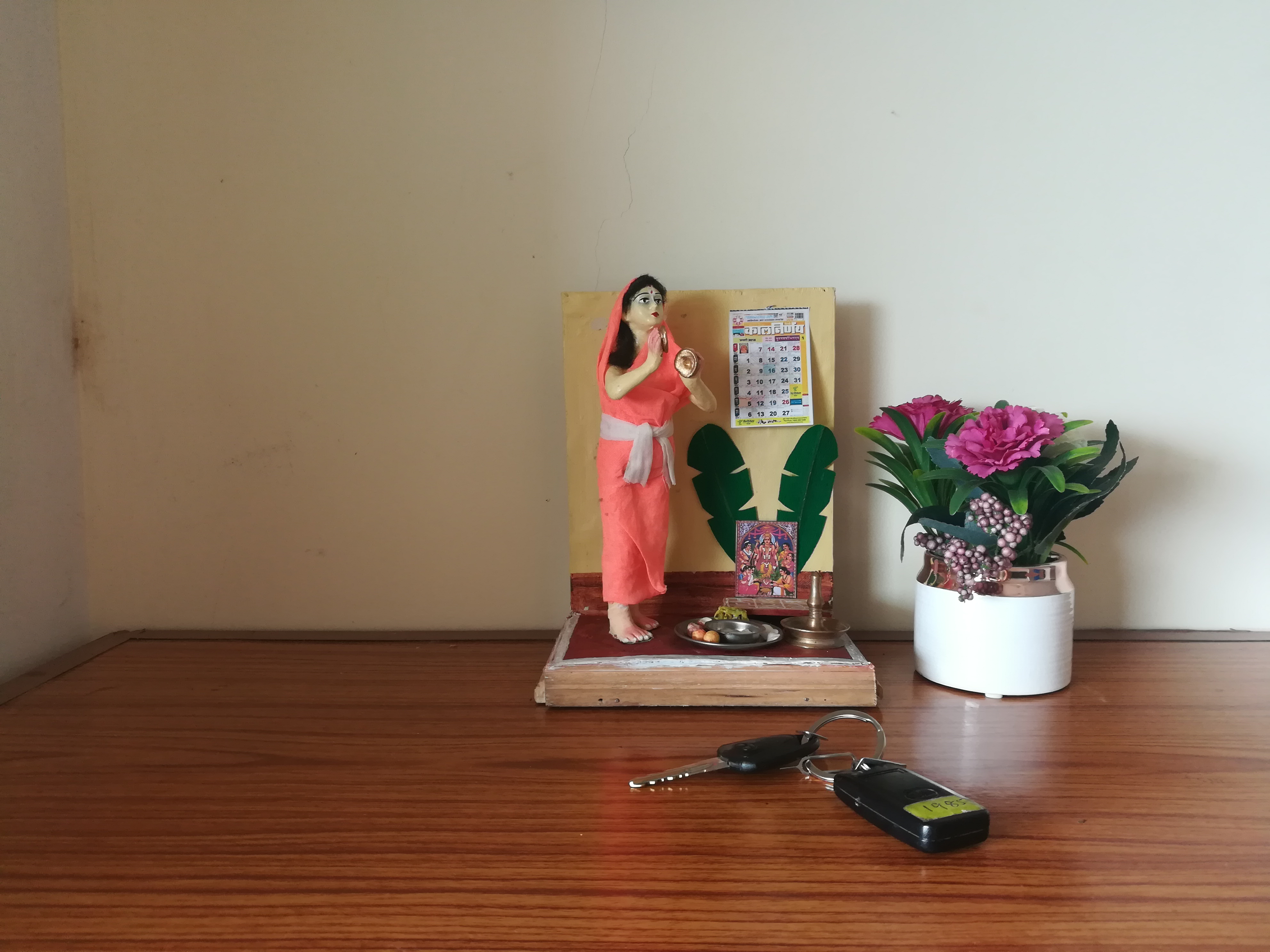
I choose the subject of the artworks from different distinct cultures. In the first series, I covered the culture of North Indian. In order to get more clarity on their historical aspects, I will treat a whole article on each of them

while working and observing the pattern of learning for kids in past 3 years , I found that there are mainly 7 ways to make them learn anything –

1-visual, 2- aural, 3- social, 4-solitary, 5- physical, 6- logical, 7-verbal.
Here parents, teachers, friends and society play a great role in building the character and cultural knowledge of the children because only parents and teachers can play the best role in connecting them to their culture as they are the closest to them. I strongly believe that the visual, social and verbal communication bridge will be an alternative to keep children away from screen entertainment where they are only trapped in someone else’s simulation.
Knowledge of culture will open up a whole new realm of imagination and understanding for Cultural Revolution. It will give them food for thought to play with their own imagination.
Boredom challenges children to discover their own passions
If you go back a few hundred years, learning was always one that took place in an open space through constant interaction and personal experience.In the last few decades, somewhere in between, learning is compressed into closed spaces and teaching becomes more theoretical where there is only constant interaction but no space for personal experience. We need to understand that not all learning takes place in classrooms ” compare and contrast knowledge gained through personal experience. To develop personal experience, you needed time to interact with yourself, to become curious about your interests.

Sports, music, and other organized activities can certainly enhance a child’s physical, cognitive, cultural, and social development. But children also need time to themselves – Remember, children are always happiest in self-directed play. This is because play is what children do. It’s how they learn to process the emotions and experiences they’ve had.

Observe any group of playing children, and they will organize themselves into some sort of activity, whether it be building a human train, pretending to be a doctor, and attending to the problems of patients.

Sometimes I’ve noticed that parents often feel guilty when children complain about boredom. But actually, it’s more constructive to see boredom as an opportunity rather than a deficit. Parents should understand that rushing in with ready-made solutions is not helpful.

Boredom plays a crucial role in child development because it gives children the opportunity to explore their inner and outer worlds, which is the beginning of creativity. This is how they learn to engage with themselves and the world, to imagine, invent and create.
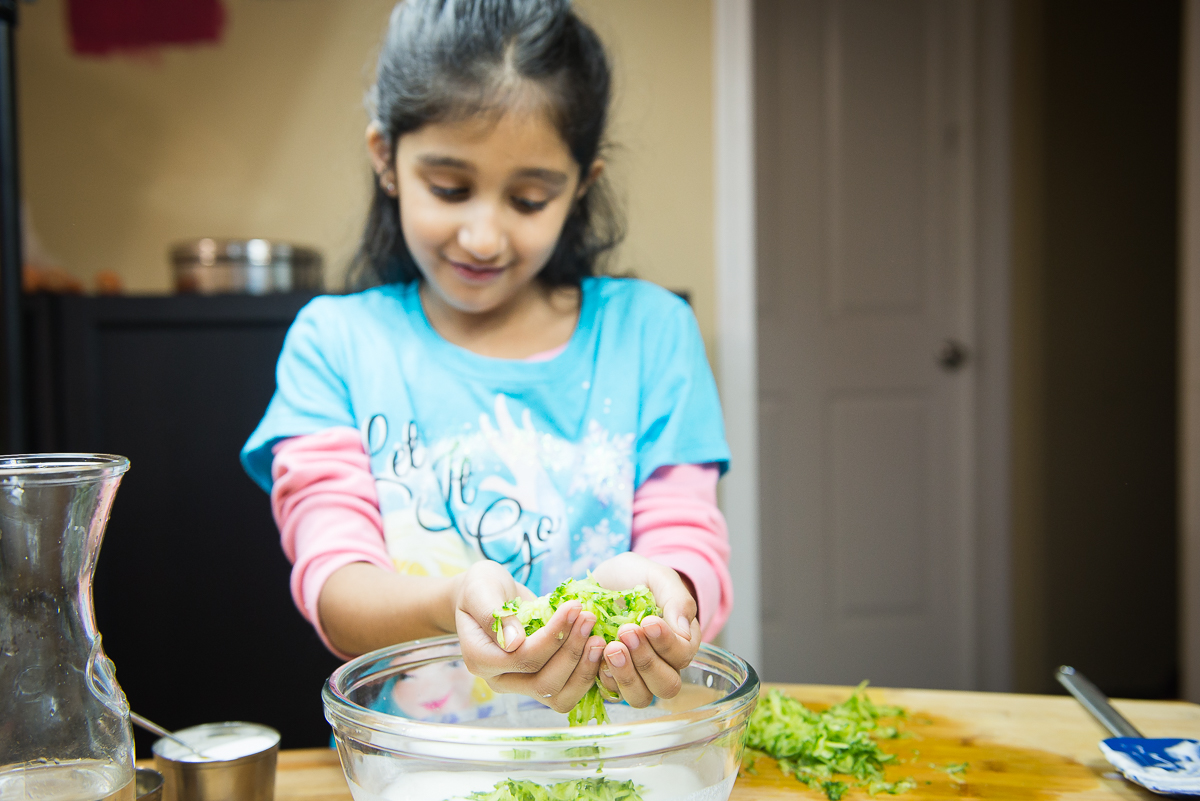
Boredom challenges children to discover their own passions. When we keep them busy with lessons and structured activities or fill their time with screen entertainment, they never learn to act on their own interests, which might include making a doll out of scraps of fabric, writing a short story, or simply reading comic books or imagining their own superhero and his new superpowers.

It is these calls of our heart that lead us to those passions that make life meaningful, and they are available to us from childhood – but only if children are given free rein to explore and pursue where their interests lead them.
 Indeed, there is a lesson here for all of us. Switching off, doing nothing and letting your mind wander can be great for adults too – we should try that ..
Indeed, there is a lesson here for all of us. Switching off, doing nothing and letting your mind wander can be great for adults too – we should try that ..
‘GANGOUR’ The festival of Isar and Gour.
Gangour is one of the most celebrated festivals in Rajasthan. The festival marks the beginning of the spring season in the state. it is started in the middle of March with a series of celebrations that last for almost 18 days!
The word ‘Gangur’ is made up of two words, ‘Gana’ and ‘Gaur’. ‘Gana’ is synonymous with Lord Shiva and ‘Gaur’ stands for Gauri (Parvali), the Goddess Gauri who symbolizes Soubhagya (marital bliss). The Gangaur festival is widely known and celebrated with enthusiasm throughout the state of Rajasthan. Gangaur is a festival of the women ; Gangaur is celebrated in honor of Goddess Gauri who is a symbol of virtue, devotion, fertility and a perfect married woman.

The small idols of Shiva and Gauri are usually made of wood or clay mud. These divine male and female entities are called ‘Isar’ and ‘Gauri’. It is mandatory for a newly married girl to observe the full course of the 18 days of the festival and fast to ensure that her marriage do well, even unmarried girls fast and eat only one meal a day.

Let me now take you through the proceedings of the festivities!
The celebrations begin almost two weeks before the main day of the festival.The women worship the goddess throughout the two weeks before the main day of the festival. A group of women from the city hold a procession and carry colorful idols of Gouri. Many people from the surrounding villages come to participate in the procession and move with them from village to village.


On the main day of this festival, women wake up before sunrise. Before worship, newly-weds and unmarried girls leave the house with an earthen pot with a lamp in it, called “Ghudlia”, on their heads to collect fresh water and fresh flowers near the pond while returning to the house, the women sing hymn and (Mangal) songs.

Having made the house sacred by sprinkling it with this water, the women construct a square pedestal, twenty-four fingers high and twenty-four fingers long, of the sacred clay, while this pooja, as a symbol of virtue, sixteen points with kuncum, sixteen points with mehndi, and sixteen points with kajal.

Women Decorate the Isar and Gauri with beautiful clothes and ornaments specially made for the occasion.the beautifully decorated idols look like they are brought to life by these girls and married women. Women worship ten forms of Mother Gauri: Gauri, Uma, Latika, Subhaga, Bhagmalini, Manokamna, Bhavani, Kamada, Bhog Vardavini and Ambika, with great devotion and faith.

The idol of Isar and Gouri, which is placed on the head of married women, is taken in procession in the afternoon to a garden, bawakdi, or fountain. Vidaai songs are sung as Gouri leaves for her husband’s house, after which they return home. These prayers are continued continuously for 18 days and are concluded with the arrival of Lord Shiva to escort his bride home.
The married women worship Gauri for the welfare, health and longevity of her husband and a happy married life. While unmarried girls worship the Goddess to get the husband of their choice. They sing bhajans or devotional songs as part of Gangour Puja. During Gangour festival several fairs or Jatra are celebrated in Jaipur, Udaipur and many other cities in Rajasthan.

Gauri and Isar idols are carried in solemn procession through various parts of the city. Once the religious part of the festival is over, the time for cultural events begins, where Rajasthani culture is showcased through songs, dance and various cultural activities.

On the last day the procession ends with the visarjan (immersion) of all the idols in the water of Gangour Ghats. The women bid farewell to Gouri and return towards home with tears in their eyes, and in this way Gangour Festival comes to an end.

‘Kaavad’ A traditional masterpiece of storytelling
Storytelling, it’s a part of Indian rich heritage. It defines our culture and our identity. Storytellers spread the important messages and lessons via their stories, with the help of voice and gestures. They use different mediums along with it like painted scrolls, boxes, dance and music performance or a combination of all to make their message even more crisp and thoughtful. Storytelling is an ART!! And Kaavads are the masterpiece of this Art!
The Kaavad is a portable wooden temple/shrine that has visual narratives on its multiple panels that are hinged together. These panels can be opened into many layers, similar to crossed thresholds of a temple, unfolding its deepest secret.The picture painted on the panels depict episodes of a particular tale or a series of epic stories .‘Kaavad Banchana’, a storytelling tradition, is still alive in Rajasthan using stories of the epics Mahabharata, Ramayana, Puranas and folk traditions are told in a magnificent and astonishing manner.

The Kaavad-storytellers are called Kaavadiya Bhat.They bring the shrine to their patron’s house to recite their genealogy and stories from the Hindu epic.The Kaavadiyas (storytellers) and their jujmans (hereditary patrons) consider the Kaavad as a sacred shrine, which demands certain rituals to be followed, listening to genealogies, epic stories and making donations. It is believed that listening to stories purifies the soul and reserves a place for the devotee in heaven.The Kaavad tradition is approximately 400 years old and like several other oral storytelling traditions in India, its origin is located in mythology or attributed to a mysterious power.
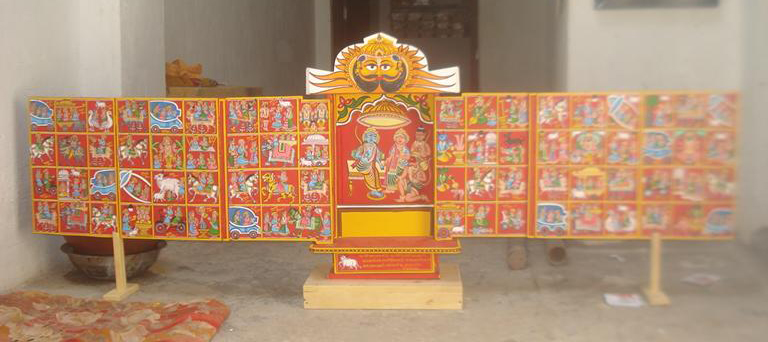
Kaavad is made by the Suthar (carpenter) community in Mewar, situated amidst the hills of the Aravalli ranges in Rajasthan. The specific identity of Kaavad makers comes from the place Bassi, the place where Kaavads are originated from. The Suthars of Bassi calls themselves the children of Visvakarma, the God who is considered as the chief architect of the Universe and the father of carpenter community. Out of 25 families of Suthars in Bassi only five to six families are involved in making of Kaavads.
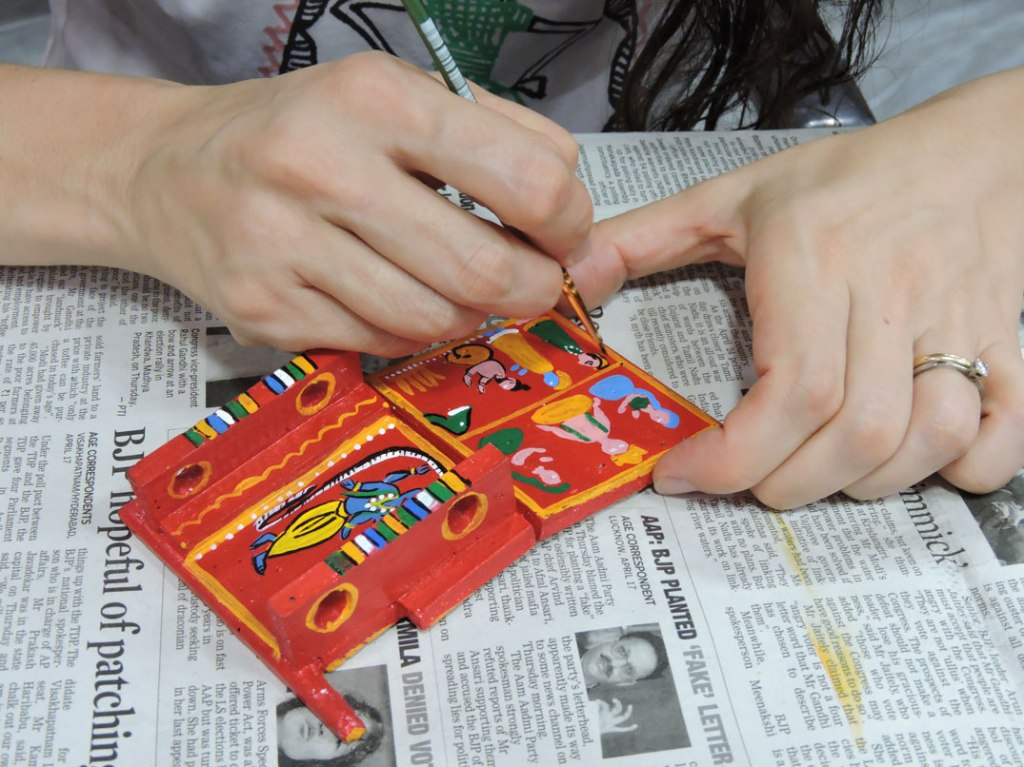
Kaavadiyas procure Kaavads from the Suthars of Bassi and then travel along with it from village to village to tell a lot of marvelous stories. On his arrival at a village, the storyteller holds the Kaavad against his chest, tilted slightly backward so that everybody could see the mobile Kaavad-shrine.During Kaavad bhachana, he sits crossed legged and keeps Kaavad over his lap.

The story begins by opening the small outer doors revealing the decorations on the outer panels to arouse the curiosity by talking through the highlights of the stories depicted in the Kaavad.The storyteller then opens a ‘donations’ flap located under the decorated panels.The storyteller opens panels, one by one, telling the unveiling the several episodes of the tale.Sometimes a story could last for several days. One Kavad can contain many linked tales.The grand finale of the tales comes as the storyteller opens the final panels to reveal a ‘shrine’ –housing 3D sculptures of the hero, his wife, companions, and other characters of the story, where everyone lives happily ever after.
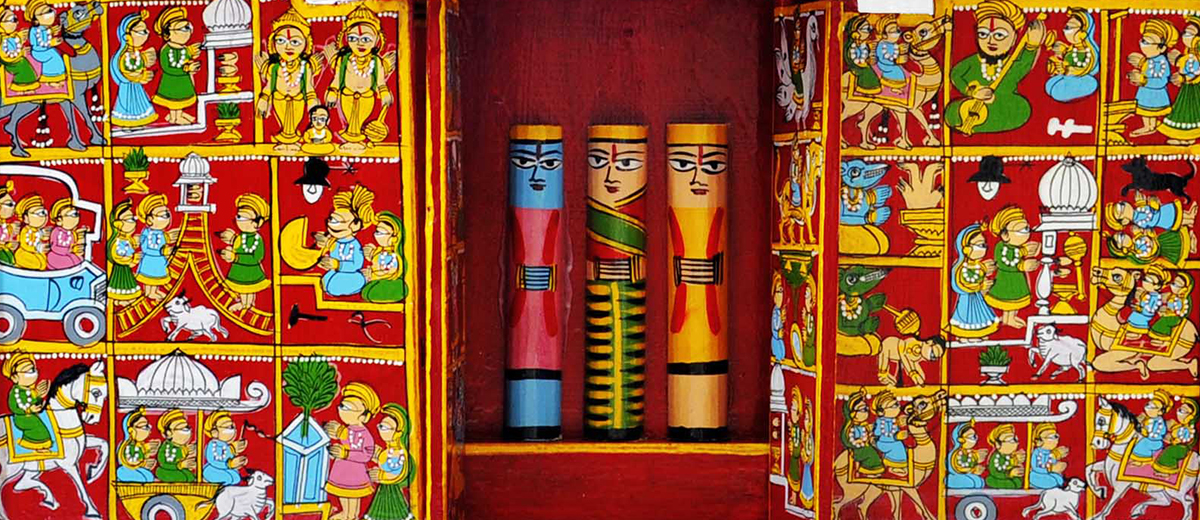

Storytelling of tribal tradition….
“Jhabua” famous for doll making, the locals refer to call this doll making as ‘Adivasigudiyashilp’.

Jhabua is predominantly a tribal district located in the western part of Madhya Pradesh. Bhils, Bhilalas and Bhagoria tribal communities are mainly found there. Jhabua has all district level basic necessary infrastructure and administration like government hospital, bus stand, magistrate court, police headquarters and markets.

Though urbanization is stimulating the lifestyle of these rural Adivasis, one can still find a handful of successor of Adivasi culture in weekly Haat bazaars (markets). In these haat bazaars, you can get a variety of handmade material products including bamboo products, dolls, beaded jewelry and other indigenous items.
In these Haats,the Bhagoriya Haat Festival is very famous. Bhagoria is not just a festival but actually a series of festivals held consecutively in different villages on their specific market days, starting eight days before Holi. I have heard many interesting facts about the Bhagoriya Hat Bazaar. In the past, the Bhagoria haat was the place for settling old disputes; open invitations were sent to enemies to fight in the haat. Bloody fights were quite common in the past; but today police and administration do not allow people to go armed to the haat.

Another interesting fact is that earlier there was no concept of matrimonial so this festival became a place where boys and girls of marriageable age meet and run away after choosing a partner (Run Away is Bhag in Hindi, so we call this community Bhagoria), As per tradition, the boy and girl apply Gulal (colored powder) on each other’s face whom they want as a spouse. This may not happen immediately, but the boy may pursue her and eventually succeed.
If I were one of this tribal community, I would dress up in my best outfits and makeup before embarking on the groom search. Otherwise, looking for a groom in urban cities is a task of wild goose chase. Well, jokes apart!!!😊 .So, as I mentioned, you will find boys and girls in their traditions attire during this Bhagoria haat festival.
I visited this Haat bazaar last year to compare the similarity of these dolls and I found that these dolls are really a symbolic representation of the Bhil and Bhilala tribe and their historical ethnicity.
The tradition of doll making in Jhabua is many generations old. These dolls represent the lifestyle of tribal men and women in colorful traditional outfits and ornaments. They adorn the female doll with silver jewelry like Galsan Mala (pearl necklace) or Chaandi ki Hansli (silver necklace), Kadas (bangles) and colorful Bhagoriya bridal wear Ghagra/Choli along with small utensils like bamboo baskets and earthenware.

On the other hand, the male counterparts in Dhoti & Kurti are seen with traditional Teer Kaamthi (bow and arrow) – highlighting hunting and gathering as primitive pursuits of this tribe. Such symbolic representation of the Bhil and Bhilala tribe, its existence and ethos, makes these small dolls an important medium of expression of historical ethnicity.

As raw materials they use colorful scraps of fabric, clay, plaster, cotton, wires, beads, metal jewelry, silver paint, and bamboo. The facial expressions are painted with great attention to detail. These dolls in themselves tell their glorious traditional stories. Different variety of these dolls u can find at ‘Shakti Emporium’ known as ‘Gudiya Ghar’ owned by a private entrepreneur Mr. Subhash Gidvani who has been practicing it for 35 years.

The “Ganjifa” Indian playing cards.
Why does a language or a culture live or die? It does not matter whether it was a script or a dialect, whether it belonged to the common people or to the high-end trend.
“If it is in use, it will live; if not, it will not survive long”.
In my opinion, the same is true of traditional Indian practices. I believe the only way to restore the glory of our traditional customs is to use them again. However, we may have to modernize them to fit into our contemporary lifestyle
So today we are going to talk about a tradition that is on the verge of extinction: “The Indian Ganjifa Playing Cards”.

I rarely show any interest in playing cards. Having grown up in a North Indian middle class state, my mother was of the opinion that these playing cards were the beginning of gambling addiction. To keep us away from this obsession, she never let us touch playing cards. But here I came to know something very interesting about these playing cards. While researching about handmade toys and games, I came across the treasure of Indian hand painted playing cards called “GANJIFFA” and “GANJAPPA” cards…..as every existing thing has its origin story, so do these cards. Let us dive deeper into it.

It is said that there were playing cards in India about a thousand years ago, in the 7th century, known in Sanskrit as Kreeda Patra. However, many scholars suggest that the origin of playing cards was in China and then they reached Central and Western Asia in the 13th century.

In the 16th Sawantwadi Ganjifa of Maharashtra, Navadurga Ganjifa of Orissa, Rajasthan and Gujarat Ganjifa, Kashmir Ganjifa, Nepal Ganjifa and Mysore Ganjifa.
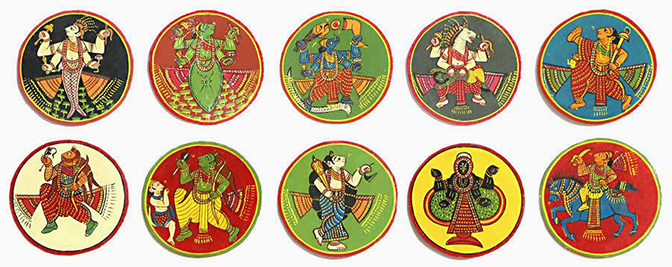


Mughals miniature style Ganjifa cards
Mysore style of Ganjifa cards

These cards are still played in some places in India today, although since the late 19th century they have been supplanted by the mass-produced French playing cards we know today.

Many of you must be thinking that if the Mughals bring it and patronize it to prosper, then how does this Hindu iconography come across these cards?
“During the Muslim period, when Islam was the predominant religion.

So the Ganjifa cards also had a religious purpose. People chanted the names of deities while playing these cards, creating a spiritual atmosphere. Mythological symbols and deities were artistically painted on the cards by the artists and the Ganjifa art excelled in subtlety, richness, colors, novelty and above all expression.
Ganjifa art, an entertaining, intelligent and witty game, enjoyed great popularity in the Middle Ages, but its name and fame are now in decline. With the fall of blue-blooded kingdoms and empires. Ganjifa cards are hardly sold in shops today. With the advent of the digital age and the influx of modern printed cards, Ganjifa artists have lost not only patronage but also recognition.

Lord Jagannath and his siblings, Balabhadra and Subhadra.
 We covered many heritage toys stories from north, south and west, how could we forgot to Raghurajpur . On the mapping of traditionally rich heritage places, you will found Raghurajpur painted with bold strokes. Raghurajpur heritage craft village is in Odisha, 14 km away from Hindu pilgrimage town of Puri. Raghurajpur renowned to produce different varieties of handicrafts.
We covered many heritage toys stories from north, south and west, how could we forgot to Raghurajpur . On the mapping of traditionally rich heritage places, you will found Raghurajpur painted with bold strokes. Raghurajpur heritage craft village is in Odisha, 14 km away from Hindu pilgrimage town of Puri. Raghurajpur renowned to produce different varieties of handicrafts.

This is the only village in India, where each family is engaged in one craft or the other such as patta paintings, palm leaf engravings, papermache toys and masks, wood carvings, wooden toys, cow dung toys and so on. Raghurajpur a place where arts and crafts have reached its stage of excellence.

There are barely a hundred homes in this village. Narrow houses located on either side of narrow lanes, a temple on each lane, a sit out area in front of each house, total wooden interiors (beams, pillars, doors and the likes) and traditional decor is how Raghurajpur looks at first glance. but once u enter u will found every home is an studio and every another person is an artist or a chitrakar, creating and preserving the traditional art form of Pattachitra and other carft painted with Pattachitra. In this village you will found fascinating murals painted on the outer walls of every home.

The reigning theme is the portrait of the three faces that fill up every space on the walls: the triad deities of Puri – Lord Jagannath and his siblings, Balabhadra and Subhadra. Almost every art form in this village is inspired by them.
As I always talks about cultural art toys and artifacts over my blog, here also we will talk upon those features only.
Coconut n betel nut painting-
coconut shell called nadia are inexpensive in Orissa, given its long coastline where coconut trees grow in abundance. Decorative and utility items crafted from coconut shells work out cheaper on account of the low cost of raw material,and less labour involved in comparison to betel nut carving.

on these shells, where the triad deities smile at me.
Cow dung toys–
From centuries, toys made from cowdung have severed as cheap substitutes to wooden and metal toys, especially for marginalized communities. The raw material is free and production cost is negligible almost. They are mostly made by womens of stone carvers community, these brightly painted toys are rustic in design. Birds, animals are popular motifs as are statuettes of lard jagannath and his companions.

These are sold in local markets . cowdung enjoyed a great deal of value in india and is thought of as holy as well as having antiseptic property.
Papier-mâché masks–
Like other handicrafts linked with Raghurajpur, this handicraft made from wet waste paper too has its origin at this heritage village. Local pattachitra artists uses natural colours & mythological figures to make this masks.

It can be used as wall hanging, toys & as puja idol. Masks of demons can also be used in front of houses to ward off evil eyes.

Ettikoppaka is famous for its age-old tradition of sparkling colorful wooden toys and objects.
I have never been in the south (South of India) before. The Past from few months being in Bangalore I get this chance to know the culture customs n believes of them. Though language is an issue between us, but curiosity n eagerness breaks all barrios. I interact with artisans of these toys makers to get to know their all aspects which make them so exquisite. From south zone These prominent toys names are very famous, Ettikoppaka, Chennapatnam , Kondapalli. Let’s start talk about Ettikoppaka, cause rest I already cover in my previous articles before.

Ettikoppaka is a village in Andhra Pradesh (India), famed for its toys and decorative artefacts on the banks of the Varaha River, the name Etikoppaka means itself, a group of houses on the banks of the river.It is 65 km from Visakhapatnam. The village economy is mostly based on farming. Ettikoppaka , is famous for two things The first ever cooperative sugar factory in the country and second for, the lac industry.
The origination of these toys tradition consist a history behind itself.The villages around Koppaka (place in Visakhapatnam district) have always been involved in producing handicrafts of weaving, brass works, and the wooden article/toy making. The Ettikoppaka toy making industry has its origin in Nakkapalli, a village next to Koppaka which originally know by the name ‘Laccapalli’. About a hundred years ago, the village held the monopoly in making colorful miniature pillars, decorative arches and jharokas, which were assembled together to make the elaborate temple carts. Orders for such articles came from distant temple towns like Kanchipuram, Tanjore and Puri. The artisans kept the finer points of lac making and lacquer coating a closely guarded secret during that time. Around the turn of the century, the landlords of Etikoppaka resettled the artisans of Nakkapalli at Ettikoppaka, where the cottage industry flourished. More than 200 artisan families living in this village currently.
Ettikoppaka is famous for its age-old tradition of sparkling colorful wooden toys and objects. .Ettikoppaka toys are made of soft and fine grain ‘Ankudu woods’. Women and children pick it up from nearby hills and leave it to dry in the courtyards. The workplace and tools are primitive. It is a wonder that with these primitive tools, objects of such skill originate here.
The toys are given shape with the help of turnwood machine. Zero emery paper is used to smooth the surface of the wood. Then colored lac is applied on the wood, which spreads uniformly due to the heat. After applying colored lac, the wood is polished with keora leaf, which contains silicate and fatty acids. Stones are used to blend the colors. The black color is obtained from haritaki fruit. The yellow is rendered by wild turmeric, red from zafran while green is made by mixing indigo and wild turmeric.

Ettikoppka has GI (Geographical Identification) tag registration since from 2004. GI tag give a unique identity to any product especially toys and handicrafts that help the industry and artisans from the onslaught of duplicacy. GI helps to promote a product globally and also provides protection from others making it at any other location than the place it originated.

So that’s the rigorous task behind it to make these toys exquisite since from ages.
Hope u praise from the very next time while buying Ettikoppaka toys the passion tradition and patience of these toys makers.
Develop values of tolerance, acceptance and kindness among kids for different culture.
Why is it important to teach children about our culture? Why is it equally important for children to spend time to learn from other’s culture and to respect it? How do we teach them tolerance, acceptance, and kindness? As a guardian, you’ve to likely ponder yourself in all of these questions.
On the broader vision,
What is culture?
Best designed solutions, to make way of life interesting, smooth and organized for indigenous people and communities. Every designed solution(Culture), before to get its place in society, went through systematic designed process behind it.
That process gets influenced with many indigenos factors of mythology, history, believes, skills, climate condition and available sources of material .

It’s not enough only to get to know any particular culture, until u not dig deep into its designed process. That would be the real learning which will make logical sense to your kids about any culture..
For learning interaction is must. Tangible visual literacy can be great mean to make kids curious to gain more and more knowledge about the subject..
Being willing to give curiosity to see people of other cultures helps children to grow up in an accepting atmosphere, and teach them to respect differences they will surely encounter as they continue to grow and learn.


 We all know it’s important to prepare children to thrive in an ever-changing and increasingly-diverse population, And doing so can be a balancing act between maintaining pride and love for one’s own culture while remaining curious, tolerant, and accepting for those who are different from us. Ultimately, the goal is to raise culturally aware kids to equip them with the attitudes and skills necessary to be able to live together peacefully with others amidst difference
We all know it’s important to prepare children to thrive in an ever-changing and increasingly-diverse population, And doing so can be a balancing act between maintaining pride and love for one’s own culture while remaining curious, tolerant, and accepting for those who are different from us. Ultimately, the goal is to raise culturally aware kids to equip them with the attitudes and skills necessary to be able to live together peacefully with others amidst difference


We believe, Play has an important role in learning and emotional development of all children. Play helps children to learn relationship, social skills and develop values and ethics. In India where we have diverse culture and ethnicity exist side by side, Learning and to appreciate it should be began at the early ages. On that note our toys can provide a tangible experience and opportunity for kids to build an understanding about the diverse culture of India. Toys speak lot about the cultural heritage of a place; they depict the rich history, mythology, culture and social life style of the people residing there. Through toys we can speculate a lot about any particular place and culture . This is what i believe in, what’s you perspective ?




